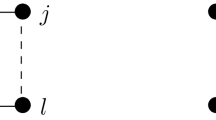Abstract
A matrix A is said to have rigidity s for rank r if A differs from any matrix of rank r on more than s entries. We prove that random n-by-n Toeplitz matrices over \({\mathbb{F}_{2}}\) (i.e., matrices of the form \({A_{i,j} = a_{i-j}}\) for random bits \({a_{-(n-1)}, \ldots, a_{n-1}}\)) have rigidity \({\Omega(n^3/(r^2\log n))}\) for rank \({r \ge \sqrt{n}}\), with high probability. This improves, for \({r = o(n/\log n \log\log n)}\), over the \({\Omega(\frac{n^2}{r} \cdot\log(\frac{n}{r}))}\) bound that is known for many explicit matrices.
Our result implies that the explicit trilinear \({[n]\times [n] \times [2n]}\) function defined by \({F(x,y,z) = \sum_{i,j}{x_i y_j z_{i+j}}}\) has complexity \({\Omega(n^{3/5})}\) in the multilinear circuit model suggested by Goldreich and Wigderson (Electron Colloq Comput Complex 20:43, 2013), which yields an \({\exp(n^{3/5})}\) lower bound on the size of the so-called canonical depth-three circuits for F. We also prove that F has complexity \({\tilde{\Omega}(n^{2/3})}\) if the multilinear circuits are further restricted to be of depth 2.
In addition, we show that a matrix whose entries are sampled from a \({2^{-n}}\)-biased distribution has complexity \({\tilde{\Omega}(n^{2/3})}\), regardless of depth restrictions, almost matching the known \({O(n^{2/3})}\) upper bound for any matrix. We turn this randomized construction into an explicit 4-linear construction with similar lower bounds, using the quadratic small-biased construction of Mossel et al. (Random Struct Algorithms 29(1):56–81, 2006).
Similar content being viewed by others
References
Alon N., Goldreich O., Håstad J., Peralta R. (1992) Simple Construction of Almost k-wise Independent Random Variables. Random Structures and Algorithms 3(3): 289–304
A. E. Andreev (1987). On a method for obtaining more than quadratic effective lower bounds for the complexity of \({\pi}\)-schemes. Moscow Univ. Math. Bull. 42, 63–66. In Russian.
Bürgisser P., Lotz M. (2004) Lower bounds on the bounded coefficient complexity of bilinear maps. J. ACM 51(3): 464–482
Friedman J. (1993) A note on matrix rigidity. Combinatorica 13(2): 235–239
O. Goldreich (2008). Computational Complexity: A Conceptual Perspective. Cambridge University Press.
O. Goldreich & A. Tal (2016). Matrix rigidity of random Toeplitz matrices. In STOC, 91–104.
O. Goldreich & A. Wigderson (2013). On the Size of Depth-Three Boolean Circuits for Computing Multilinear Functions. Electronic Colloquium on Computational Complexity (ECCC) 20, 43.
J. Håstad (1989). Almost Optimal Lower Bounds for Small Depth Circuits. In RANDOMNESS AND COMPUTATION, 6–20. JAI Press.
S. Kopparty, M. Kumar & M. E. Saks (2014). Efficient Indexing of Necklaces and Irreducible Polynomials over Finite Fields. In ICALP, 726–737.
R. Lidl & H. Niederreiter (1997). Finite Fields, volume 20 of Encyclopedia of mathematics and its applications. Cambridge University Press, 2nd edition.
Lokam S.V. (2009) Complexity Lower Bounds using Linear Algebra. Foundations and Trends in Theoretical Computer Science 4(1–2): 1–155
Mossel E., Shpilka A., Trevisan L. (2006) On epsilon-biased generators in \({NC^{0}}\). Random Structures and Algorithms 29(1): 56–81
Naor J., Naor M. (1993) Small-Bias Probability Spaces: Efficient Constructions and Applications. SIAM J. on Computing 22(4): 838–856
Paturi R., Pudlák P., Saks M.E., Zane F. (2005) An improved exponential-time algorithm for k-SAT. J. ACM 52(3): 337–364
R. Paturi, P. Pudlák & F. Zane (1999). Satisfiability Coding Lemma. Chicago J. Theor. Comput. Sci. 1999.
Raz R. (2003) On the complexity of matrix product. SIAM J. on Computing 32(5): 1356–1369
Shokrollahi M.A., Spielman M.A., Stemann V. (1997) A Remark on Matrix Rigidity. Inf. Process. Lett. 64(6): 283–285
L. G. Valiant (1977). Graph-theoretic arguments in low-level complexity. In Lecture notes in Computer Science, volume 53, 162–176. Springer.
Author information
Authors and Affiliations
Corresponding author
Rights and permissions
About this article
Cite this article
Goldreich, O., Tal, A. Matrix rigidity of random Toeplitz matrices. comput. complex. 27, 305–350 (2018). https://doi.org/10.1007/s00037-016-0144-9
Received:
Published:
Issue Date:
DOI: https://doi.org/10.1007/s00037-016-0144-9



